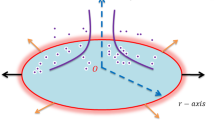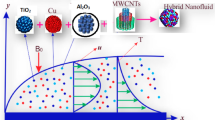Abstract
Nano-fluidic flow and heat transfer around a horizontal cylinder at Reynolds numbers up to 250 are investigated by using weakly compressible smoothed particle hydrodynamics (WCSPH). To be able to simulate enhanced nanoparticle heat transfer, this manuscript describes for the first time a development that allows conductive and convective heat transfer to be modelled accurately for the Eckert problem using WCSPH. The simulations have been conducted for Pr = 0.01–40 with nanoparticle volumetric concentrations ranging from 0 to 4%. The velocity fields and the Nusselt profiles from the present simulations are in a good agreement with the experimental measurements. The results show that WCSPH is appropriate method for such numerical modelling. Additionally, the results of heat transfer characteristics of nano-fluid flow over a cylinder marked improvements comparing with the base fluids. This improvement is more evident in flows with higher Reynolds numbers and higher particle volume concentration.







Similar content being viewed by others
Abbreviations
- B :
-
Constant in equation of state
- c o :
-
Artificial speed of sound
- C p :
-
The specific heat at constant pressure
- C v :
-
The specific heat at constant volume
- D :
-
Cylinder diameter
- e :
-
Energy of a given particle
- f :
-
Arbitrarily function
- h :
-
Smoothing length or support dimension
- H :
-
Computational domain height
- k :
-
Thermal conductivity of fluid
- L :
-
Computational domain length
- m :
-
Mass of a given particle
- Nu :
-
Nusselt number
- P :
-
Pressure acting on the particle
- Pr :
-
Prandtl number
- Q :
-
Heat flux terms in energy equation
- r :
-
Distance between the centres of a couple of particles
- r :
-
Position vector identifying the equilibrium state
- Re :
-
Reynolds number
- t :
-
Time
- T :
-
Temperature
- u :
-
Velocity component along x-axis
- v :
-
Velocity component along y-axis
- V :
-
Volume of the particle i
- W :
-
Kernel or smoothing function
- x :
-
The first Cartesian coordinate axis
- y :
-
The second Cartesian coordinate axis
- δ :
-
Dirac delta function
- σ :
-
Stress tensor
- μ :
-
Viscosity coefficient
- ρ :
-
Mass density
- ν :
-
Kinematic viscosity
- γ :
-
Constant in state equation
- φ :
-
Nanoparticle volume fraction
- ε :
-
Parameter of artificial viscous heating
- 0:
-
Value for reference condition
- Cut:
-
Cutting radius
- i:
-
Particle of interest
- j:
-
Neighbour particle
- f:
-
Fluid
- nf:
-
Nano-fluid
- s:
-
Solid nanoparticle
References
Kramers HA. Heat transfer from spheres to flowing media. Physica. 1945;12:61–80.
Perkins H. Forced convection heat transfer from a uniformly heated cylinder. J Heat Transf. 1962;84:257–63.
Perkins H, Leppert G. Local heat-transfer coefficients on a uniformly heated cylinder. Int J Heat Mass Transf. 1964;7:143–58.
Fand RM. Heat transfer by forced convection from a cylinder to water in crossflow. Int J Heat Mass Transf. 1965;8:995–1010.
Zukauskas A, Ziugzda J. Heat transfer of a cylinder in crossflow. Washington: Hemishere Pub; 1985.
Whitaker S. Forced convection heat transfer calculations for flow in pipes, past flat plate, single cylinder, and for flow in packed beds and tube bundles. AIChE J. 1972;18:361–71.
Churchill S, Bernstein M. A correlating equation for forced convection from gases and liquids to a circular cylinder in cross flow. J Heat Transf. 1977;99:300–6.
Sanitjai S, Goldstein R. Heat transfer from a circular cylinder to mixtures of water and ethylene glycol. Int J Heat Mass Transf. 2004;47:4785–94.
Sanitjai S, Goldstein RJ. Forced convection heat transfer from a circular cylinder in crossflow to air and liquids. Int J Heat Mass Transf. 2004;47:4795–805.
Haeri S, Shrimpton J. On the application of immersed boundary, fictitious domain and body-conformal mesh methods to many particle multiphase flows. Int J Multiph Flow. 2012;40:38–55.
Mittal R, Balachandar S. Effect of three-dimensionality on the lift and drag of nominally two-dimensional cylinders. Phys Fluids. 1995;7:1841–65.
Williamson CHK. Vortex dynamics in the cylinder wake. Annu Rev Fluid Mech. 1996;28:477–539.
Singh SP, Mittal S. Energy spectra of flow past a circular cylinder. Int J Comput Fluid Dyn. 2004;18:671–9.
Sharma N, Patankar N. A fast computation technique for the direct numerical simulation of rigid particulate flows. J Comput Phys. 2005;205:439–57.
Yu Z, Shao X. A direct-forcing fictitious domain method for particulate flows. J Comput Phys. 2007;227:292–314.
Apte SV, Martin M, Patankar NA. A numerical method for fully resolved simulation (FRS) of rigid particle-flow interactions in complex flows. J Comput Phys. 2009;228:2712–38.
Peskin CS. The immersed boundary method. Acta Numer. 2002;11:479–517.
Griffith BE, Hornung RD, McQueen DM, Peskin CS. An adaptive, formally second order accurate version of the immersed boundary method. J Comput Phys. 2007;223:10–49.
Roma A, Peskin C, Berger M. An adaptive version of the immersed boundary method. J Comput Phys. 1999;153:509–34.
Luci L. A numerical approach to the testing of the fission hypothesis. Astron J. 1977;82:1013–24.
Gingold RA, Monaghan JJ. Smoothed particle hydrodynamics: Theory and application to non-spherical stars. Sci Math MNRAS. 1977;181:375–89.
Shadloo MS, Weiss R, Yildiz M, Dalrymple RA. Numerical simulations of the breaking and non-breaking long waves. Int J Offshore Polar Eng. 2015;25(1):1–7.
Shadloo MS, Le Touze D, Oger G. Mesh-free Lagrangian modelling of fast flow dynamics, Manuscript No.: 2015-TPC-0750. In: The 25th international ocean and polar engineering conference, June 21–26, 2015, Kona, Big Island.
Shadloo MS, Yildiz M. Numerical modeling of Kelvin–Helmholtz instability using smoothed particle hydrodynamics method. Int J Numer Methods Eng. 2011;87:988–1006.
Shadloo MS, Zainali A, Yildiz M. Simulation of single mode Rayleigh–Taylor instability by SPH method. Comput Mech. 2013;51:699–715.
Fatehi R, Shadloo MS, Manzari MT. Numerical investigation of two-phase secondary Kelvin–Helmholtz instability. J Mech Eng Sci. 2014;228:1913–24.
Shadloo MS, Rahmat A, Yildiz M. A smoothed particle hydrodynamics study on the electrohydrodynamic deformation of a droplet suspended in a neutrally buoyant Newtonian fluid. Comput Mech. 2013;52:693–707.
Abdollahzadeh Jamalabadi MY, Ovosi M. Numerical simulation of interaction of a current with a circular cylinder near a rigid bed. J Appl Math Phys. 2016;4:398–411.
Zainali A, Tofighi N, Shadloo MS, Yildiz M. Numerical investigation of Newtonian and non-Newtonian multiphase flows using ISPH method. Comput Methods Appl Mech Eng. 2013;254:99–113.
Shamsoddini R, Sefid M, Fatehi R. Incompressible SPH modeling and analysis of non-Newtonian power-law fluids, mixing in a microchannel with an oscillating stirrer. J Mech Sci Technol. 2016;30(1):307–16.
Esmaili Sikarudi MA, Nikseresht AH. Neumann and Robin boundary conditions for heat conduction modeling using smoothed particle hydrodynamics. Comput Phys Commun. 2016;198:1–11.
Rook R, Yildiz M, Dost S. Modeling transient heat transfer using SPH and implicit time integration. Numer Heat Transf B. 2007;51:1–23.
Devendiran DK, Amirtham VA. A review on preparation, characterization, properties and applications of nanofluids. Renew Sustain Energy Rev. 2016;60:21–40.
Esfe MH, Karimipour A, Yan WM, Akbari M, Safaei MR, Dahari M. Experimental study on thermal conductivity of ethylene glycol based nanofluids containing Al2–O3 nanoparticles. Int J Heat Mass Transf. 2016;88:728–34.
Esfe MH, Saedodin S, Akbari M, Karimipour A, Afrand M, Wongwises S, Safaei MR, Dahari M. Experimental investigation and development of new correlations for thermal conductivity of CuO/EG–water nanofluid. Int Commun Heat Mass Transf. 2015;65:47–51.
Karimipour A, Esfe MH, Safaei MR, Semiromi DT, Jafari S, Kazi SN. Mixed convection of copper–water nanofluid in a shallow inclined lid driven cavity using the lattice Boltzmann method. Physica A. 2014;402:150–68.
Mahian O, Kianifar A, Kalogirou SA, Pop I, Wongwises S. A review of the applications of nanofluids in solar energy. Int J Heat Mass Transf. 2013;57(2):582–94.
Karimipour A, D’Orazio A, Shadloo MS. The effects of different nano particles of Al2 O3 and Ag on the MHD nano fluid flow and heat transfer in a microchannel including slip velocity and temperature jump. Phys E Low Dimens Syst Nanostruct. 2017;86:146–53.
Rashidi MM, Nasiri M, Shadloo MS, Yang Z. Entropy generation in a circular tube heat exchanger using nanofluids: effects of different modeling approaches. Heat Transf Eng. 2017;38(9):853–66.
Safaei MR, Gooarzi M, Akbari OA, Shadloo MS, Dahari M. Electronics cooling, chapter 6. In: Sohel Murshed SM, editor. Performance evaluation of nanofluids in an inclined ribbed microchannel for electronic cooling applications. ISBN 978-953-51-2406-1, Print ISBN 978-953-51-2405-4; Published: June 15, 2016.
Loya A, Stair JL, Ren G. Simulation and experimental study of rheological properties of CeO2–water nanofluid. Int Nano Lett. 2015;5(1):1–7.
Safaei MR, Shadloo MS, Goodarzi MS, Hadjadj A, Goshayeshi HR, Afrand M, Kazi SN. A survey on experimental and numerical studies of convection heat transfer of nanofluids inside closed conduits. Adv Mech Eng. 2016;8(10):1–14.
Rea U, McKrell T, Hu L-W, Buongiorno J. Laminar convective heat transfer and viscous pressure loss of alumina–water and zirconia–water nanofluids. Int J Heat Mass Transf. 2009;52(7–8):2042–8.
Zeinali Heris S, Etemad SG, Nasr Esfahany M. Experimental investigation of oxide nanofluids laminar flow convective heat transfer. Int Commun Heat Mass Transf. 2006;33(4):529–35.
Ebrahimnia-Bajestan E, Niazmand H, Duangthongsuk W, Wongwises S, Renksizbulut M. Numerical investigation of effective parameters in convective heat transfer of nanofluids flowing under laminar flow regime. Int J Heat Mass Transf. 2011;54(19–20):4376–88.
R Vignjevic, J Campbell, Review of development of the smooth particle hydrodynamics (SPH) method. In: Predictive modeling of dynamic processes. Springer; 2009, p 367–396.
Batchelor GK. Introduction to fluid dynamics. Cambridge: Cambridge University Press; 1974.
Monaghan JJ. Simulating free surface flows with SPH. J Comput Phys. 1994;110:399–406.
Monaghan JJ. Smoothed particle hydrodynamics. Annu Rev Astron Astrophys. 1992;30:543–74.
Rahmat A, Tofighi N, Shadloo MS, Yildiz M. Numerical simulation of wall bounded and electrically excited Rayleigh Taylor instability using incompressible smoothed particle hydrodynamics. Colloids Surfaces A. 2014;460:60–70.
Shadloo MS, Zainali A, Sadek SH, Yildiz M. Improved incompressible smoothed particle hydrodynamics method for simulating flow around bluff bodies. Comput Methods Appl Mech Eng. 2011;200(9):1008–20.
Fatehi R, Manzari MT. Error estimation in smoothed particle hydrodynamics and a new scheme for second derivatives. Comput Math Appl. 2011;61(2):482–98.
Liu GR, Liu MB. Smoothed particle hydrodynamics: a meshfree particle method. Singapore: World Scientific Publishing Co Pte Ltd; 2003. ISBN 978-981-238-456-0.
Karimipour Arash. A novel case study for thermal radiation through a nanofluid as a semitransparent medium via discrete ordinates method to consider the absorption and scattering of nanoparticles along the radiation beams coupled with natural convection. Int Commun Heat Mass Transf. 2017;87:256–69.
Ghasemi S, Karimipour A. Experimental investigation of the effects of temperature and mass fraction on the dynamic viscosity of CuO-paraffin nanofluid. Appl Therm Eng. 2018;128:189–97.
Aramesh M, Pourfayaz F, Kasaeian A. Numerical investigation of the nanofluid effects on the heat extraction process of solar ponds in the transient step. Sol Energy. 2017;157:869–79.
Kasaeian A, Pourfayaz F, Khodabandeh E, Yan WM. Experimental studies on the applications of PCMs and Nano-PCMs in buildings: a critical review. Energy Build. 2017;154:96–112.
Eckert ERG, Soehngen E. Distribution of heat transfer coefficients around circular cylinders in cross flow at Reynolds numbers from 20 to 500. J Heat Transf. 1952;74:343–7.
Shadloo MS, Zainali A, Yildiz M, Suleman A. A robust weakly compressible SPH method and its comparison with an incompressible SPH. Int J Numer Method Eng. 2012;89(8):939–56.
Author information
Authors and Affiliations
Corresponding author
Rights and permissions
About this article
Cite this article
Nasiri, H., Abdollahzadeh Jamalabadi, M.Y., Sadeghi, R. et al. A smoothed particle hydrodynamics approach for numerical simulation of nano-fluid flows. J Therm Anal Calorim 135, 1733–1741 (2019). https://doi.org/10.1007/s10973-018-7022-4
Received:
Accepted:
Published:
Issue Date:
DOI: https://doi.org/10.1007/s10973-018-7022-4




